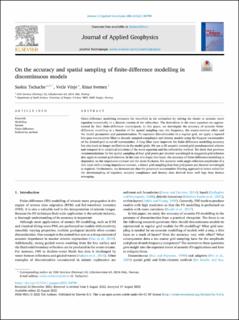| dc.contributor.author | Tschache, Saskia | |
| dc.contributor.author | Vinje, Vetle | |
| dc.contributor.author | Iversen, Einar | |
| dc.date.accessioned | 2022-09-06T12:55:25Z | |
| dc.date.available | 2022-09-06T12:55:25Z | |
| dc.date.created | 2022-09-05T13:53:26Z | |
| dc.date.issued | 2022 | |
| dc.identifier.issn | 0926-9851 | |
| dc.identifier.uri | https://hdl.handle.net/11250/3016047 | |
| dc.description.abstract | Finite-difference modelling estimates the wavefield in the subsurface by solving the elastic or acoustic wave equation numerically in a discrete version of the subsurface. The derivatives in the wave equation are approximated by their finite-difference counterparts. In this paper, we investigate the accuracy of acoustic finite-difference modelling as a function of the spatial sampling rate, the frequency, the source-receiver offset and the model parameters and parametrisation. To represent discontinuities in a regular grid, we apply a tapered low-pass wavenumber filter to densely sampled compliance and density models using the Nyquist wavenumber of the desired grid as cut-off wavenumber. A long filter taper improves the finite-difference modelling accuracy but also leads to longer oscillations in the model grids. We use a 2D acoustic central-grid pseudospectral scheme and compare it to analytical solutions of the wave equation and the reflectivity method. We show that previous recommendations for the spatial sampling of four grid points per shortest wavelength in staggered-grid schemes also apply to central-grid schemes. In the case of a single thin layer, the accuracy of finite-difference modelling is dependent on the impedance contrast and the layer thickness. For accurate wide-angle reflection amplitudes of a thin layer with a strong impedance contrast, a denser grid sampling than four grid points per shortest wavelength is required. Furthermore, we demonstrate that the presented wavenumber filtering approach is better suited for the downsampling of regularly sampled compliance and density data derived from well logs than Backus averaging. | en_US |
| dc.language.iso | eng | en_US |
| dc.publisher | Elsevier | en_US |
| dc.rights | Navngivelse 4.0 Internasjonal | * |
| dc.rights.uri | http://creativecommons.org/licenses/by/4.0/deed.no | * |
| dc.title | On the accuracy and spatial sampling of finite-difference modelling in discontinuous models | en_US |
| dc.type | Journal article | en_US |
| dc.type | Peer reviewed | en_US |
| dc.description.version | publishedVersion | en_US |
| dc.rights.holder | Copyright 2022 The Author(s) | en_US |
| dc.source.articlenumber | 104789 | en_US |
| cristin.ispublished | true | |
| cristin.fulltext | original | |
| cristin.qualitycode | 1 | |
| dc.identifier.doi | https://doi.org/10.1016/j.jappgeo.2022.104789 | |
| dc.identifier.cristin | 2048897 | |
| dc.source.journal | Journal of Applied Geophysics | en_US |
| dc.relation.project | Norges forskningsråd: 310441 | en_US |
| dc.identifier.citation | Journal of Applied Geophysics. 2022, 206, 104789. | en_US |
| dc.source.volume | 206 | en_US |

